A Novel Colorimetric Chemosensor Based on Ferene-S-Conjugated Silver Nanoparticles for Selective Recognition of Fe2+
Abstract
:1. Introduction
2. Materials and Methods
2.1. Material and Instruments
2.2. Synthesis of Ferene-S-Conjugated AgNPs
3. Results and Discussion
3.1. UV-Visible Spectral Analysis of Ferene-S-Conjugated AgNPs
3.2. Comparative FTIR of Ferene-S and Ferene-S-Conjugated AgNPs
3.3. Particle-Size Determination through AFM, SEM, and Analysis of MALDI-TOF Spectrometry
3.4. Ferene-S-Conjugated AgNPs as a Potential Chemosensing Probe
3.5. Interference Study in Real Samples and Binding Study of Ferene-S-AgNPs with Fe2+
3.6. Detection Limit of the Probe and Effect of pH on the Ferene-S-AgNPs–Fe2+ Complex
4. Conclusions
Supplementary Materials
Author Contributions
Funding
Institutional Review Board Statement
Informed Consent Statement
Data Availability Statement
Acknowledgments
Conflicts of Interest
References
- Willets, K.A.; van Duyne, R.P. Localized surface plasmon resonance spectroscopy and sensing. Annu. Rev. Phys. Chem. 2007, 58, 267–297. [Google Scholar] [CrossRef] [Green Version]
- Fulekar, M. Nanotechnology: Importance and Applications; IK International Pvt Ltd.: Delhi, India, 2010. [Google Scholar]
- Liz-Marzán, L.M.; Touriño, I.L. Reduction and Stabilization of Silver Nanoparticles in Ethanol by Nonionic Surfactants. Langmuir 1996, 12, 3585–3589. [Google Scholar] [CrossRef]
- Jung, J.H.; Lee, J.H.; Shinkai, S. Functionalized magnetic nanoparticles as chemosensors and adsorbents for toxic metal ions in environmental and biological fields. Chem. Soc. Rev. 2011, 40, 4464–4474. [Google Scholar] [CrossRef]
- Neuberger, T.; Schöpf, B.; Hofmann, H.; Hofmann, M.; von Rechenberg, B. Superparamagnetic nanoparticles for biomedical applications: Possibilities and limitations of a new drug delivery system. J. Magn. Magn. Mater. 2005, 293, 483–496. [Google Scholar] [CrossRef]
- Mirza, S.; Ahmad, M.S.; Shah, M.I.A.; Ateeq, M. Magnetic Nanoparticles: Drug Delivery and Bioimaging Applications. In Metal Nanoparticles for Drug Delivery and Diagnostic Applications; Elsevier: Amsterdam, The Netherlands, 2020; pp. 189–213. [Google Scholar]
- Biju, V.; Itoh, T.; Anas, A.; Sujith, A.; Ishikawa, M. Semiconductor quantum dots and metal nanoparticles: Syntheses, optical properties, and biological applications. Anal. Bioanal. Chem. 2008, 391, 2469–2495. [Google Scholar] [CrossRef]
- Sweatlock, L.A.; Maier, S.; Atwater, H.A.; Penninkhof, J.J.; Polman, A. Highly confined electromagnetic fields in arrays of strongly coupled Ag nanoparticles. Phys. Rev. B 2005, 71, 235408. [Google Scholar] [CrossRef] [Green Version]
- Lok, C.-N.; Ho, C.-M.; Chen, R.; He, Q.-Y.; Yu, W.-Y.; Sun, H.; Tam, P.K.-H.; Chiu, J.-F.; Che, C.-M. Silver nanoparticles: Partial oxidation and antibacterial activities. JBIC J. Biol. Inorg. Chem. 2007, 12, 527–534. [Google Scholar] [CrossRef] [PubMed]
- El-Sayed, I.H.; Huang, X.; El-Sayed, M.A. Surface Plasmon Resonance Scattering and Absorption of anti-EGFR Antibody Conjugated Gold Nanoparticles in Cancer Diagnostics: Applications in Oral Cancer. Nano Lett. 2005, 5, 829–834. [Google Scholar] [CrossRef] [PubMed]
- Zak, B.; Ressler, N. Simultaneous Microdetermination of Copper and Iron Using Mixed Phenanthrolines. Anal. Chem. 1956, 28, 1158–1161. [Google Scholar] [CrossRef]
- Prosposito, P.; Burratti, L.; Venditti, I. Silver Nanoparticles as Colorimetric Sensors for Water Pollutants. Chemosensors 2020, 8, 26. [Google Scholar] [CrossRef] [Green Version]
- Sabela, M.; Balme, S.; Bechelany, M.; Janot, J.-M.; Bisetty, K. A Review of Gold and Silver Nanoparticle-Based Colorimetric Sensing Assays. Adv. Eng. Mater. 2017, 19, 1700270. [Google Scholar] [CrossRef]
- Firdaus, M.L.; Aprian, A.; Meileza, N.; Hitsmi, M.; Elvia, R.; Rahmidar, L.; Khaydarov, R. Smartphone Coupled with a Paper-Based Colorimetric Device for Sensitive and Portable Mercury Ion Sensing. Chemosensors 2019, 7, 25. [Google Scholar] [CrossRef] [Green Version]
- Dixon, S.J.; Stockwell, B.R. The role of iron and reactive oxygen species in cell death. Nat. Chem. Biol. 2014, 10, 9–17. [Google Scholar] [CrossRef]
- Enami, S.; Sakamoto, Y.; Colussi, A.J. Fenton chemistry at aqueous interfaces. Proc. Natl. Acad. Sci. USA 2014, 111, 623–628. [Google Scholar] [CrossRef] [Green Version]
- Torti, S.V.; Torti, F.M. Iron and cancer: More ore to be mined. Nat. Rev. Cancer 2013, 13, 342–355. [Google Scholar] [CrossRef] [Green Version]
- Andersen, J.E.T. A novel method for the filterless preconcentration of iron. Analyst 2005, 130, 385–390. [Google Scholar] [CrossRef] [PubMed]
- Busto, M.E.D.C.; Montes-Bayón, M.; Blanco-González, E.; Meija, J.; Sanz-Medel, A. Strategies To Study Human Serum Transferrin Isoforms Using Integrated Liquid Chromatography ICPMS, MALDI-TOF, and ESI-Q-TOF Detection: Application to Chronic Alcohol Abuse. Anal. Chem. 2005, 77, 5615–5621. [Google Scholar] [CrossRef] [PubMed]
- Pomazal, K.; Prohaska, C.; Steffan, I.; Reich, G.; Huber, J.F.K. Determination of Cu, Fe, Mn, and Zn in blood fractions by SEC-HPLC-ICP-AES coupling. Analyst 1999, 124, 657–663. [Google Scholar] [CrossRef] [PubMed]
- David, C.I.; Bhuvanesh, N.; Jayaraj, H.; Thamilselvan, A.; Devi, D.P.; Abiram, A.; Prabhu, J.; Nandhakumar, R. Experimental and Theoretical Studies on a Simple S–S-Bridged Dimeric Schiff Base: Selective Chromo-Fluorogenic Chemosensor for Nanomolar Detection of Fe2+ & Al3+ Ions and Its Varied Applications. ACS Omega 2020, 5, 3055–3072. [Google Scholar]
- Shakya, S.; Khan, I.M.; Ahmad, M. Charge transfer complex based real-time colorimetric chemosensor for rapid recognition of dinitrobenzene and discriminative detection of Fe2+ ions in aqueous media and human hemoglobin. J. Photochem. Photobiol. A Chem. 2020, 392, 112402. [Google Scholar] [CrossRef]
- Gong, X.; Zhang, H.; Jiang, N.; Wang, L.; Wang, G. Oxadiazole-based ‘on-off’ fluorescence chemosensor for rapid recognition and detection of Fe2+ and Fe3+ in aqueous solution and in living cells. Microchem. J. 2019, 145, 435–443. [Google Scholar] [CrossRef]
- Ravichandiran, P.; Boguszewska-Czubara, A.; Masłyk, M.; Bella, A.P.; Subramaniyan, S.A.; Johnson, P.M.; Shim, K.S.; Kim, H.G.; Yoo, D.J. Naphthoquinone-Based Colorimetric and Fluorometric Dual-Channel Chemosensor for the Detection of Fe2+ Ion and Its Application in Bio-Imaging of Live Cells and Zebrafish. ACS Sustain. Chem. Eng. 2019, 7, 17210–17219. [Google Scholar] [CrossRef]
- Kumar, V.V.; Anbarasan, S.; Christena, L.R.; SaiSubramanian, N.; Anthony, S.P. Bio-functionalized silver nanoparticles for selective colorimetric sensing of toxic metal ions and antimicrobial studies. Spectrochim. Acta Part A Mol. Biomol. Spectrosc. 2014, 129, 35–42. [Google Scholar] [CrossRef] [PubMed]
- Roto, R.; Mellisani, B.; Kuncaka, A.; Mudasir, M.; Suratman, A. Colorimetric Sensing of Pb2+ Ion by Using Ag Nanoparticles in the Presence of Dithizone. Chemosensors 2019, 7, 28. [Google Scholar] [CrossRef] [Green Version]
- Zhu, X.; Xiao, Y.; Jiang, X.; Li, J.; Qin, H.; Huang, H.; Zhang, Y.; He, X.; Wang, K. A ratiometric nanosensor based on conjugated polyelectrolyte-stabilized AgNPs for ultrasensitive fluorescent and colorimetric sensing of melamine. Talanta 2016, 151, 68–74. [Google Scholar] [CrossRef]
- Shah, M.R.; Ali, S.; Ateeq, M.; Perveen, S.; Ahmed, S.; Bertino, M.F.; Ali, M. Morphological analysis of the antimicrobial action of silver and gold nanoparticles stabilized with ceftriaxone on Escherichia coli using atomic force microscopy. New J. Chem. 2014, 38, 5633–5640. [Google Scholar] [CrossRef]
- Ullah, A.; Ateeq, M.; Shah, M.R.; Muhammad, M.T.; Shah, F.; Khan, I.; Fazil, P.; Khalique, A.; Khan, M. Highly selective colorimetric naked-eye Cu2+ detection using new bispyrazolone silver nanoparticle-based chemosensor. Int. J. Environ. Anal. Chem. 2018, 98, 977–985. [Google Scholar] [CrossRef]
- Ateeq, M.; Shah, M.R.; Ain, N.U.; Bano, S.; Anis, I.; Lubna; Faizi, S.; Bertino, M.F.; Naz, S.S. Green synthesis and molecular recognition ability of patuletin coated gold nanoparticles. Biosens. Bioelectron. 2015, 63, 499–505. [Google Scholar] [CrossRef]
- Ateeq, M.; Shah, M.R.; Ali, H.; Kabir, N.; Khan, A.; Nadeem, S. Hepatoprotective and urease inhibitory activities of garlic conjugated gold nanoparticles. New J. Chem. 2015, 39, 5003–5007. [Google Scholar] [CrossRef]
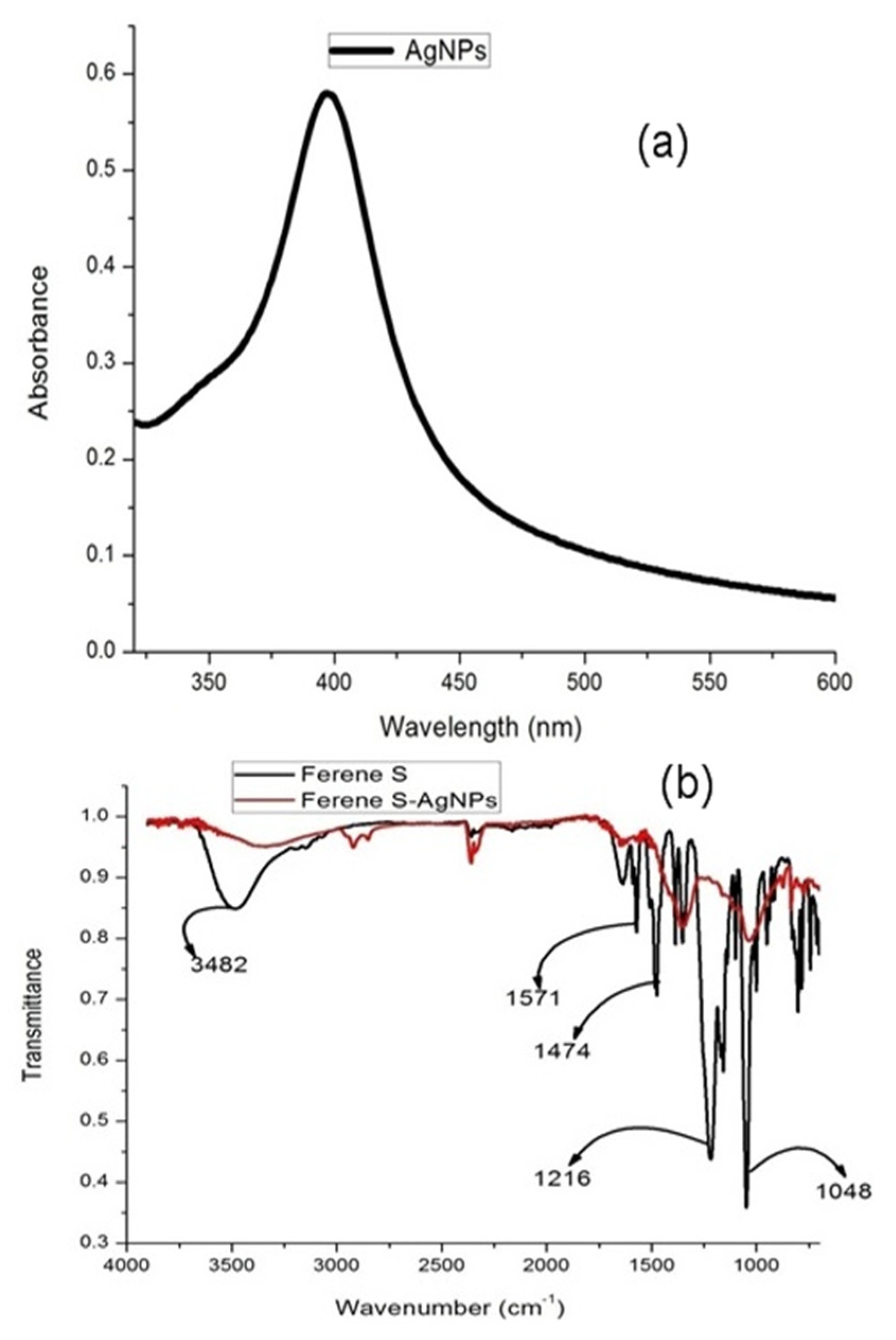

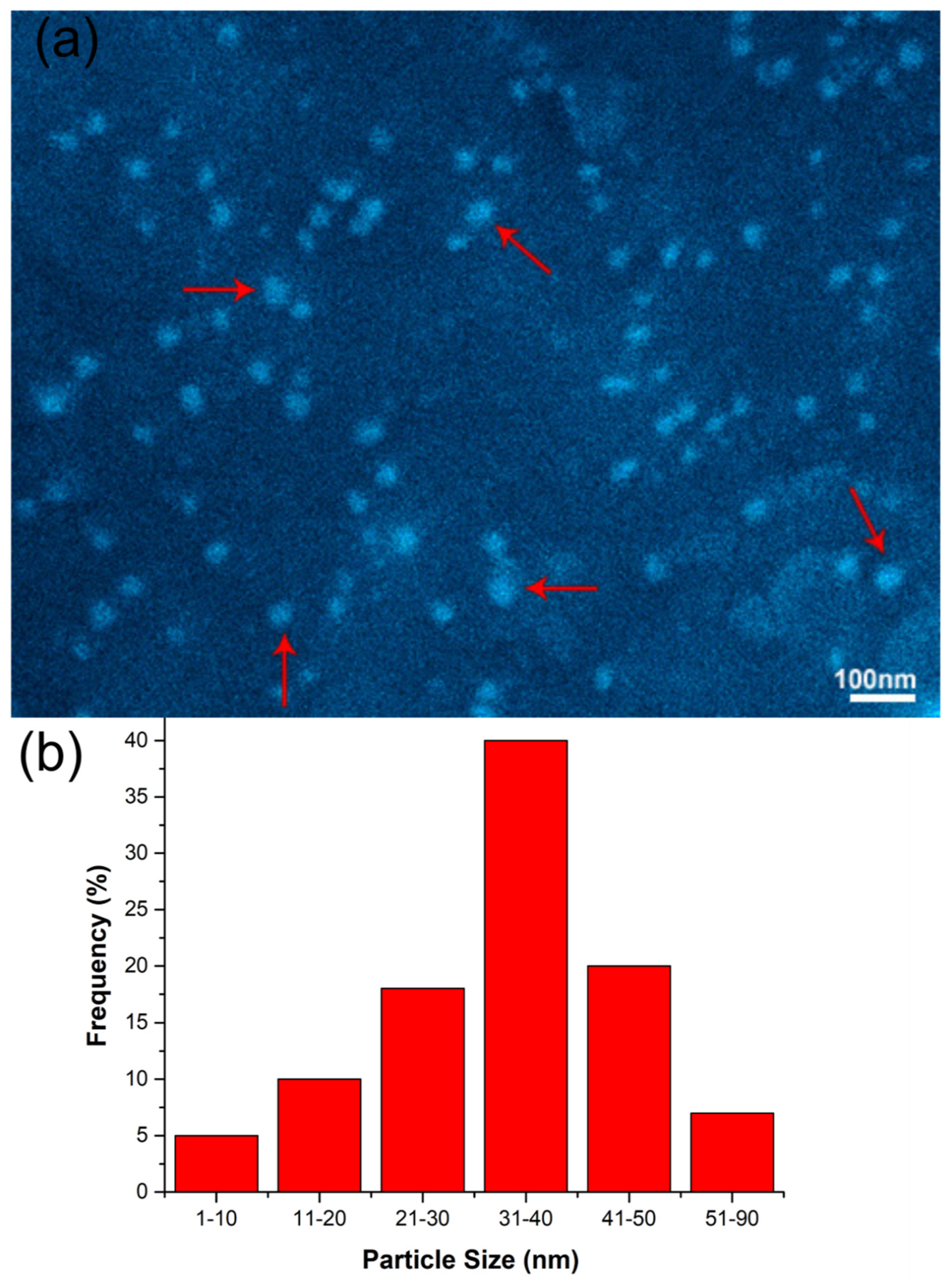
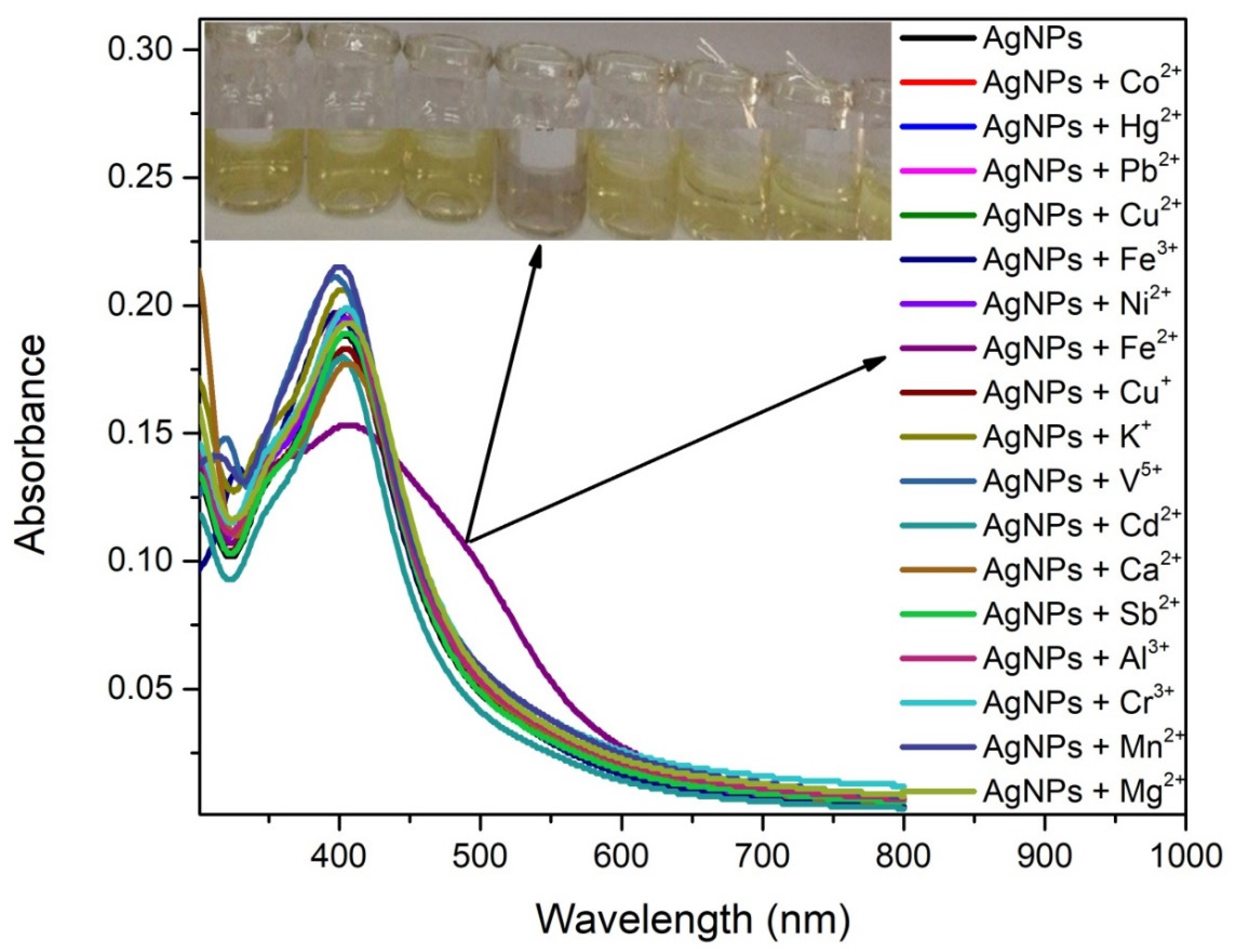
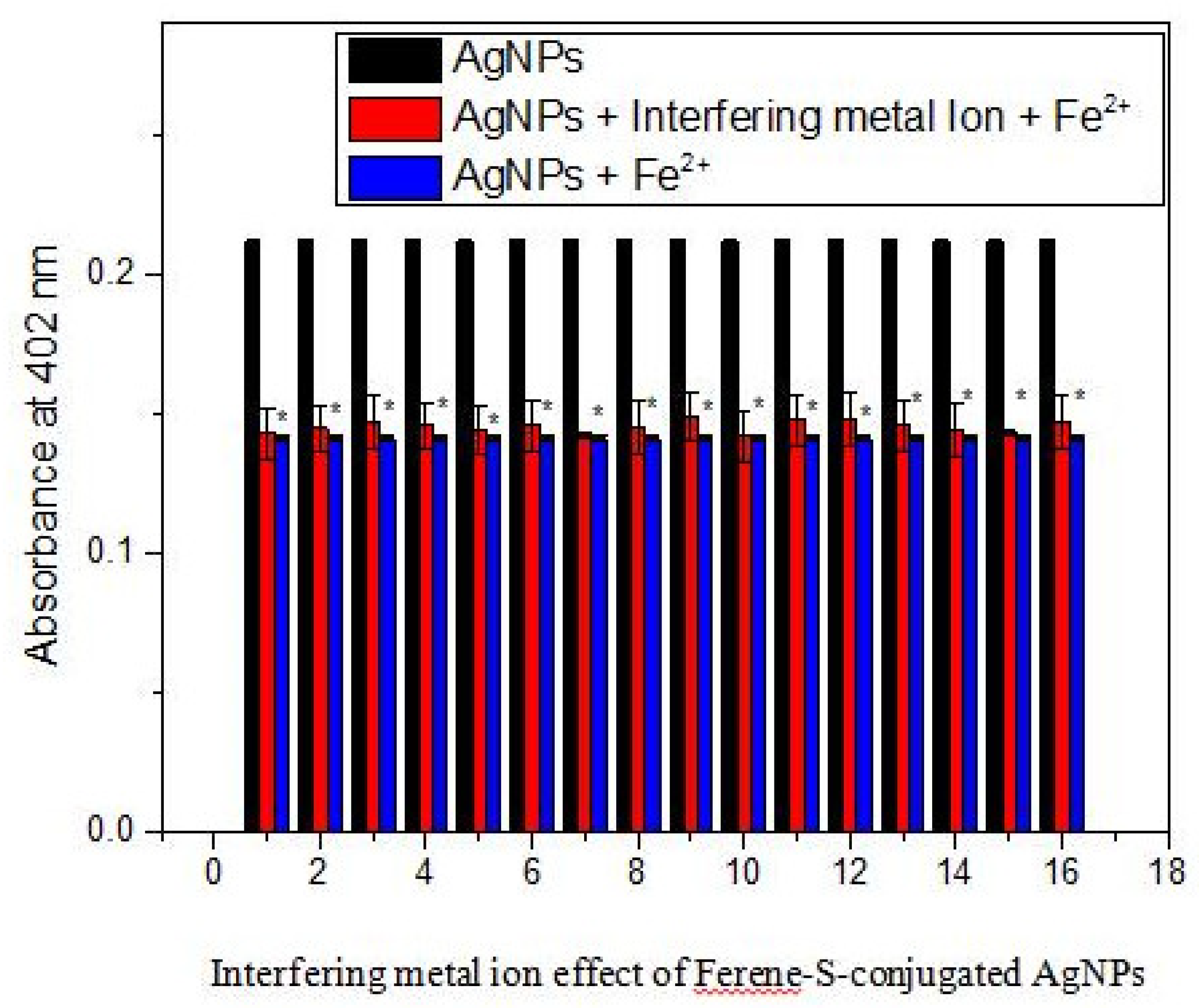
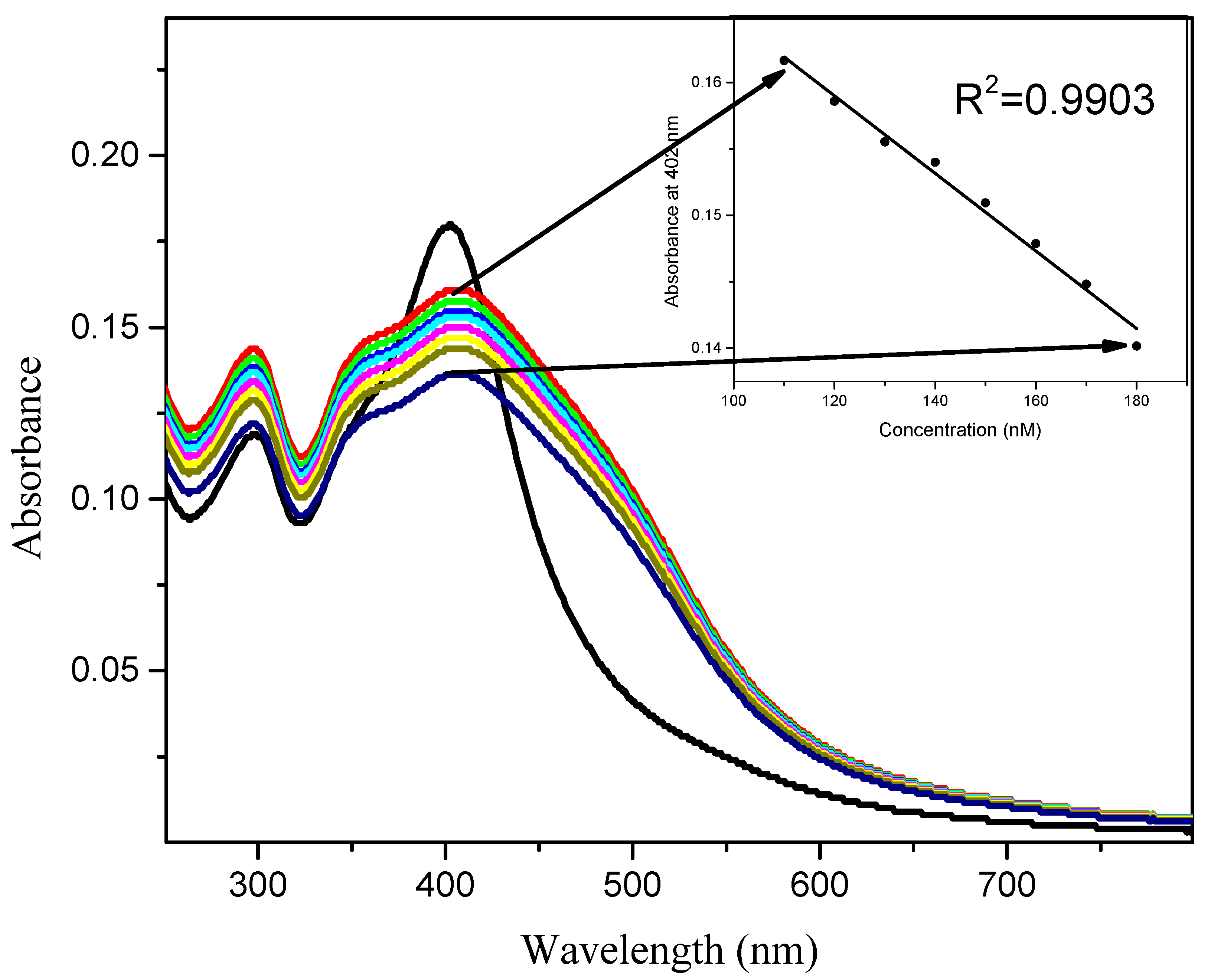
Publisher’s Note: MDPI stays neutral with regard to jurisdictional claims in published maps and institutional affiliations. |
© 2021 by the authors. Licensee MDPI, Basel, Switzerland. This article is an open access article distributed under the terms and conditions of the Creative Commons Attribution (CC BY) license (https://creativecommons.org/licenses/by/4.0/).
Share and Cite
Ullah, A.; Fazil, P.; Rukh, G.; Muhammad, M.T.; Rahim, M.; Ateeq, M.; Khattak, R.; Khan, M.S.; Abu Ali, O.A.; Saleh, D.I. A Novel Colorimetric Chemosensor Based on Ferene-S-Conjugated Silver Nanoparticles for Selective Recognition of Fe2+. Coatings 2021, 11, 1293. https://doi.org/10.3390/coatings11111293
Ullah A, Fazil P, Rukh G, Muhammad MT, Rahim M, Ateeq M, Khattak R, Khan MS, Abu Ali OA, Saleh DI. A Novel Colorimetric Chemosensor Based on Ferene-S-Conjugated Silver Nanoparticles for Selective Recognition of Fe2+. Coatings. 2021; 11(11):1293. https://doi.org/10.3390/coatings11111293
Chicago/Turabian StyleUllah, Azeem, Perveen Fazil, Gul Rukh, Munira Taj Muhammad, Muhammad Rahim, Muhammad Ateeq, Rozina Khattak, Muhammad Sufaid Khan, Ola A. Abu Ali, and Dalia I. Saleh. 2021. "A Novel Colorimetric Chemosensor Based on Ferene-S-Conjugated Silver Nanoparticles for Selective Recognition of Fe2+" Coatings 11, no. 11: 1293. https://doi.org/10.3390/coatings11111293
APA StyleUllah, A., Fazil, P., Rukh, G., Muhammad, M. T., Rahim, M., Ateeq, M., Khattak, R., Khan, M. S., Abu Ali, O. A., & Saleh, D. I. (2021). A Novel Colorimetric Chemosensor Based on Ferene-S-Conjugated Silver Nanoparticles for Selective Recognition of Fe2+. Coatings, 11(11), 1293. https://doi.org/10.3390/coatings11111293





